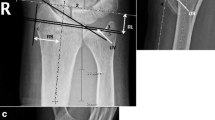Abstract
Purpose
Distal radius fractures are a common injury. In the emergency room, trainees regularly assess these fractures using visual estimation. Our hypothesis is that assessment of radiographic parameters has sufficient accuracy for rendering treatment consistent with formal measurements.
Methods
This study compared visual measurements made by 25 orthopaedic residents and attending physicians to formal measurements made by a single fellowship trained musculoskeletal radiologist in a series of patients with distal radius fractures. A search was performed utilizing the ICD-9 code for distal radius fracture in all patients presenting to a single institution emergency department. Participants used visual estimation to rate 25 radiographs. Parameters estimated included radial inclination, radial height, volar tilt, and the presence of intra-articular displacement. Analysis using Lin concordance coefficients, Bland Altman plots, and the Kappa statistic evaluated the agreement between visual estimation and formal measurements. The proportion of raters whose estimates would have resulted in a course of treatment that conflicted with the formal reading quantified the potential impact of visual estimation on treatment.
Results
Concordance coefficients were poor for radial inclination (ρc = 0.13), radial height (ρc = 0.24), and volar tilt (ρc = 0.46). The Kappa statistic for intra-articular displacement was 0.4. Analysis performed according to level of training did not result in substantial improvements in these statistics. Treatment based on visual estimates conflicted with formal readings 34 % of the time for radial inclination, 38 % of the time for radial height, 27 % of the time for volar tilt, and 31 % of the time for intra-articular displacement.
Discussion
Visual estimation is not an adequate form of measurement for evaluation of patients with distal radius fractures. Physicians should be mindful of these results when developing treatment plans based solely upon visual estimation.


Similar content being viewed by others
References
Catalano LW, 3rd, Barron OA, Glickel SZ. Assessment of articular displacement of distal radius fractures. Clin Orthop Relat Res. 2004:79-84.
Cohen MS, Jupiter JB. Fractures of the Distal Radius." Skeletal Trauma. 4th ed. Philadelphia: Saunders Elsevier; 2009. p. 1405–458.
Geissler WB. Arthroscopic Reduction and Fixation of Distal Radius and Ulnar Styloid Fractures. In: Operative Techniques in Orthopaedic Surgery. Philadelphia: Lippincott William & Wilkins; 2011:2171-2182.
Grafe MW, Kim PD, Rosenwasser MP. Distal radius fractures: External fixation. In: Wilkins LW, editor. Masters techniques in orthopaedic surgery: Fractures. 2nd ed. Philadlephia: Lippincott Williams & Wilkins; 2006. p. 169–79.
Harness NG, Ring D, Zurakowski D, Harris GJ, Jupiter JB. The influence of three-dimensional computed tomography reconstructions on the characterization and treatment of distal radial fractures. J Bone Joint Surg Am. 2006;88:1315–23.
Kreder HJ, Hanel DP, McKee M, Jupiter J, McGillivary G, Swiontkowski MF. X-ray film measurements for healed distal radius fractures. J Hand Surg [Am]. 1996;21(1):31–9.
Koval KJ, Zuckerman JD. Distal Radius. In: Handbook of Fractures. Third ed. Philadelphia:: Lippincott Williams & Wilkins; 2006:226-236.
Lafontaine M, Hardy D, Delince P. Stability assessment of distal radius fractures. Injury. 1989;20:208–10.
Medoff RJ. Essential radiographic evaluation for distal radius fractures. Hand Clin. 2005;21:279–88.
Metz VM, Gilula LA. Imaging techniques for distal radius fractures and related injuries. Orthop Clin North Am. 1993;24(2):217–28.
Pruitt DL, Gilula LA, Manske PR, Vannier MW. Computed tomography scanning with image reconstruction in evaluation of distal radius fractures. J Hand Surg [Am]. 1994;19(5):720–7.
Rachkidi R, Ghanem I, Kalouche I, El Hage S, Dagher F, Kharrat K. Is visual estimation of passive range of motion in the pediatric lower limb valid and reliable? BMC Musculoskelet Disord. 2009;10:126.
Ruch DS, McQueen MM. Distal radius and ulna fractures. Rockwood & Green's Fractures in Adults. 7th ed. Philadelphia: Lippincott Williams & Wilkins; 2010. p. 831–80.
Acknowledgments
The authors would like to acknowledge and thank the following individuals for their help in various roles of data collection and analysis: Greg Polkowski MD; Vinayak Sathe, MD; Michael Abramov, MD; Kyle Nuland, BS; and Bryan Lawlor BS.
Conflict of Interest
Michael P. O’Malley declares that he has no conflict of interest. Craig Rodner declares that he has no conflict of interest. Andrew Ritting declares that he has no conflict of interest. Mark P. Cote declares that he has no conflict of interest. Robin Leger declares that she has no conflict of interest. Harlan Stock is a reviewer for the Journal of Hand Surgery. Jennifer M. Wolf receives compensation as an editor for the Journal of Hand Surgery, as well as grant funding from OREF, AFSH, and NIH.
Statement of Human and Animal Rights
Procedures followed were in accordance with the ethical standards of the responsible committee on human experimentation (institutional and national) and with the Helsinki Declaration of 1975, as revised in 2000 and 2008.
Statement of Informed Consent
All identifying factors are eliminated form the text, including but not limited to patients' names, initials, or hospital numbers. There are no patients that are identifiable within the text.
Author information
Authors and Affiliations
Corresponding author
About this article
Cite this article
O’Malley, M.P., Rodner, C., Ritting, A. et al. Radiographic interpretation of distal radius fractures: visual estimations versus digital measuring techniques. HAND 9, 488–493 (2014). https://doi.org/10.1007/s11552-014-9666-2
Published:
Issue Date:
DOI: https://doi.org/10.1007/s11552-014-9666-2




